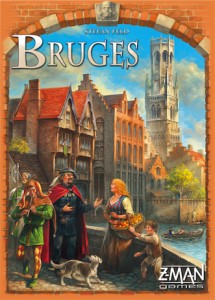 Bruges is the capital and largest city of the province of West Flanders in the Flemish Region of Belgium. But I’m sure you already knew that. I mean is there any of us that aren’t up on our Belgish (Belgiumish?) geography? Anyway, at this point you are probably wondering if I’ve lost my mind (maybe a little) and why I’m talking about random cities in Europe.
Bruges is the capital and largest city of the province of West Flanders in the Flemish Region of Belgium. But I’m sure you already knew that. I mean is there any of us that aren’t up on our Belgish (Belgiumish?) geography? Anyway, at this point you are probably wondering if I’ve lost my mind (maybe a little) and why I’m talking about random cities in Europe.
I’ve shared that little tidbit of knowledge with you because today we are going to talk about Bruges, a card game from veteran designer Stefan Feld, published by Z-Man Games. Set in the thriving city of Bruges (at least I think it’s a city, is it a village?), Bruges has you taking on the role of someone… doing something in the city. OK, let’s be honest, as with many eurogames, the theme on this one doesn’t really matter (more on that later). Instead, let’s get into the game play and see if this is a game you should be shelling out your hard-earned gaming dollars on.
Bruges is a dice rolling and hand management card game for 2-4 players that takes about 45-60 minutes to play. Bruges plays great with any number of players.
Game Overview:
Bruges is a card driven game where you will be using each card in your hand in a variety of different ways (6 to be exact). Each turn you will be trying to advance your position in the game by playing cards to earn points in one of the many different ways. In addition to being a card game, Bruges also has some dice rolling, resource management and a little engine building mixed in. The ultimate goal of the game is to score the most victory points.
Game Components:
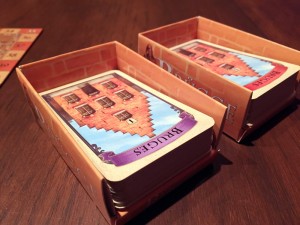
While it’s mainly a card game, Bruges does come with a lot of diverse components. The game board is the central part of your play area and is well illustrated with a picture of the city of Bruges. In the box, you will also find various cardboard tokens, wooden workers, and multi-colored dice.
The main part of Bruges is the cards though. There are 165 cards in 5 different colors. Each card has a unique person on it (yes, there are 165 different people unless I missed some duplicates) and symbols for the 5 other actions it can be used for.
One of the interesting things about the components is that the game comes with 2 card trays. These are angled slightly down so that it’s harder to see what color card back the next card coming up will be. This was a very clever addition to the game that helps prevent people from gaining knowledge they shouldn’t have.
How to Play:
Game play in Bruges is fairly straight forward and learning should be quick. The game is divided into rounds, each of which has 4 phases.
Phase 1: Draw Cards – Each player takes turns drawing up to 5 cards. You can draw from either of the 2 draw decks.
Phase 2: Roll the dice – Each of the 5 dice are rolled and placed on the game board. Any die showing a 5 or a 6 requires players to take an appropriate threat token. Collect 3 of any same colored token and you will be losing resources or cards.
Any die showing a 1 or a 2 allows players to move up the reputation track one step by paying a cost equal to the sum of all dice showing a 1 or a 2.
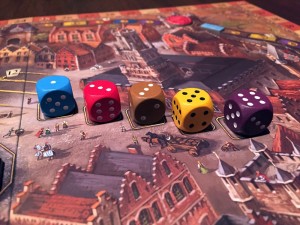
Phase 3: Play Cards – Starting with the start player, each player takes turns playing one card.
Each card can be used in one of 6 different ways:
• Take 2 Workers – Take 2 workers of a color that matches the card played.
• Take Money – Take an amount of money equal to the value of the matching color die.
• Discard a Threat marker – Discard one matching color threat market and collect 1vp.
• Build one canal – Build a matching color canal segment by paying the cost on the canal. Canals must be built from the center out.
• Build one house – Discard a matching color worker and place the card face down in your play area. You now have a house for a person.
• Recruit 1 person – After paying the cost of the person, people are played into any open house in your play area. In addition to providing victory points, all workers provide an ability or special power that players can use during the game. These range from one time bonuses, to actions powered by your workers, to additional ways to earn VPs at the end of the game.
Phase 4: After each player has played 4 of their 5 cards, they move on to phase 4. Here you check for majorities in reputation, people and canals. If you have the most, you get to flip over your scoring marker for that item.
The game ends when one of the 2 draw piles runs out. The round is finished and the final scores are tallied. Players earn points for people, houses, special abilities from people, majority markers they’ve flipped, canals, and reputation (got all that?). Whoever has the most victory points wins!
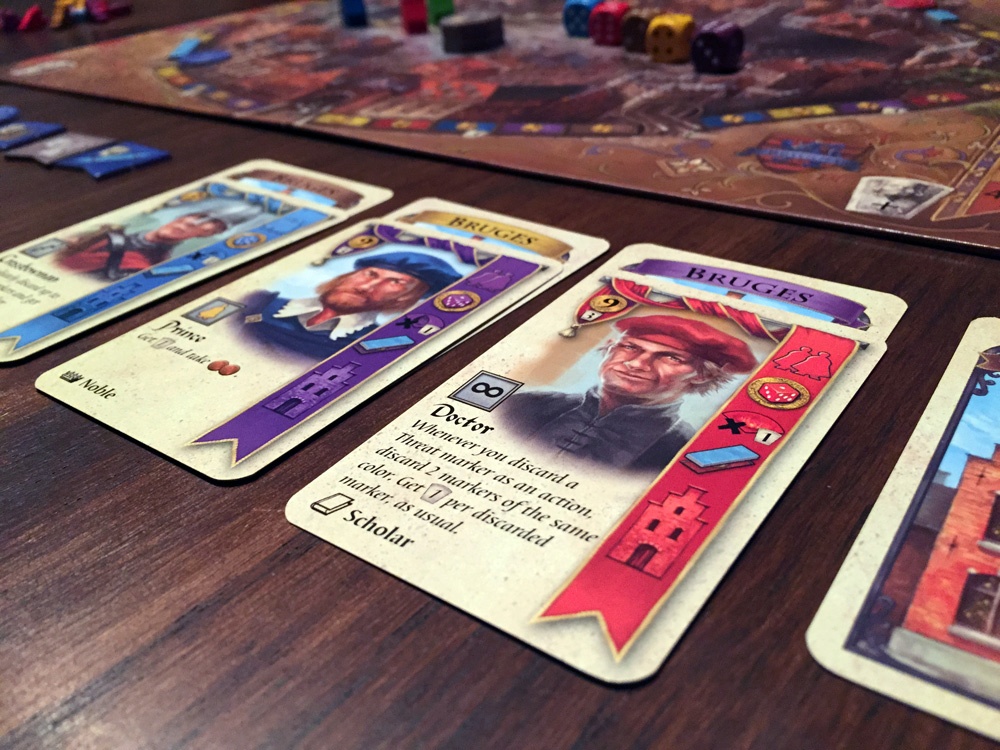
Game Experience:
I had heard good things about Bruges, but I still wasn’t sure if I was going to like it. To be honest, designer Stefan Feld’s game are very hit or miss for me. I enjoyed Amergio, but I absolutely hated Castles of Burgundy (I know I’m in in the minority on that one).
Bruges was my first card game from Feld, and in my opinion, he hit all my sweet spots on this one. I may be a little biased because card games that let me use cards in a variety of different ways has to be one of my favorite mechanics. And Bruges has that in spades.

Every card in Bruges can be used in 6 different ways! That gives me a lot of options to think about on my turn. 5 of the actions are the same on every card (varying only in the color affected) but the 6th, the recruiting actions, is where things get interesting. Each card has a unique person on it. With 165 cards in the game, Feld must have been working overtime to come up with new powers for every person. Talk about having a lot of replay value.
Although, with that great diversity, it also ensures that luck of the draw is going to play a big role in the game. I think some cards are clearly better than others. Heck, one card has already been eradicated and replaced in a recently released expansion. So if you find yourself drawing sub-optimal cards, it’s something you will have to deal with. While dealing with the card drawing you are also going to have to deal with the luck of the dice rolls. The color and value of the dice will not only affect what disaster tokens you get, but also your source of income. If you are stuck with all red cards in your hand and the red die is showing a 2, that’s not going to get you a lot of coin. However, if you can roll with these punches, Bruges can be an incredible amount of fun.
The key to winning in Bruges is to remain flexible. Not only are what characters you draw important, but the ones you choose to play that will help shape your strategy in the game. Since each card is used in a variety of ways, it will make for a lot of hard choices in the game. Do you use that card as a person for its ability or do you cash it in for a large influx of coins? It’s rare on a turn when you have nothing to do.

If you are a fan of Feld games, then you will also find one of his familiarities here. His games have been described as “point salad” games. Basically this means there is a large variety of ways to score points and just about every action you take will be towards that goal. Is that a bad thing? Ultimately that’s up to you to decide. Some say that it pretty much destroys any connection to a theme the game has. Others say it can be overwhelming to wrap your head around. For me, I’m fine with it. I like how it provides many paths to victory and provides me with a lot of options on my turn.
Going back to the theme, as mentioned earlier, Bruges is another classic eurogame where the theme is pretty much slapped on. And the point salad only helps to reinforce that. Enjoy the pretty visuals and the solid mechanics, because you aren’t going to be sucked in by its thematic game play. I’ve played the game more times than I can count and I’m not even sure what I’m actually supposed to be doing thematically. Am I’m a merchant? A lord? Maybe a real estate agent or a job recruiter.
With that many paths to victory and multiple ways to score points, there are some draw backs. First, some of the paths to victory feel a lot more rewarding than others. The canals in Bruges feel like a partially sub-optimal way to approach winning the game, especially compared to recruiting people. Although this was rectified some with The City on the Zwin expansion.
Final Thoughts:
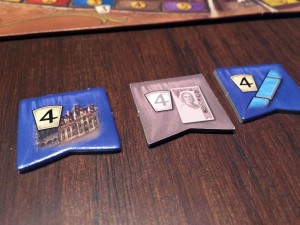
I ended up really liking Bruges. If you were around here last spring, you might also have noticed that Bruges won our 2013 Board Game Quest Award for Best Card Game. That should give you a hint to how good with think Bruges actually is.
Despite the tacked on theme, I really liked the many ways to approach the game and the immense replay value. Unless you are always playing with the maximum amount of players, you will only be using about a third to half the cards during a game.
Even with its “point salad” approach to scoring and the multi-use cards, learning Bruges is actually really easy. Most all of the actions are simple enough to learn and understand. The setup is quick, teaching should only take about 10 minutes, and overall the game play is enjoyable.
While I’ve only played a fraction of the games Stefan Feld has designed, Bruges is easily my favorite of his to date. It has already hit my gaming table multiple times and will probably continue to do so. Check this one out today!
If you’d like to grab a copy of Bruges for yourself, you can pick it up for about $49.
Final Score: 4.5 Stars – While lacking in theme, Bruges more than makes up for it with its easy to learn game play, rock solid mechanics and high replay value.
 Hits:
Hits:
• Easy to learn rules and quick setup
• High replay value
• Cards that can be used in multiple ways
• Many paths to victory
Misses:
• No connection to theme
• Higher luck factor










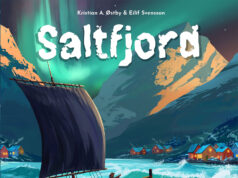
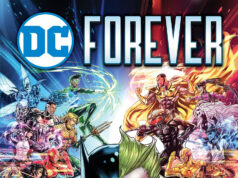












Bruges is solid. I wouldn’t have rated it as high, due to the severely pasted on theme, but that’s how I roll. We found that trying to come up with a connecting narrative made the game more fun in our experience. I’m definitely curious to give the expansion a whirl!
Such a solid game thanks for this fantastic writeup. So what’s the scoop on the city on the Zwinn expansion being out of stock everywhere? Why is this normally priced at $20 now only found online at prices between 80 and $300? !